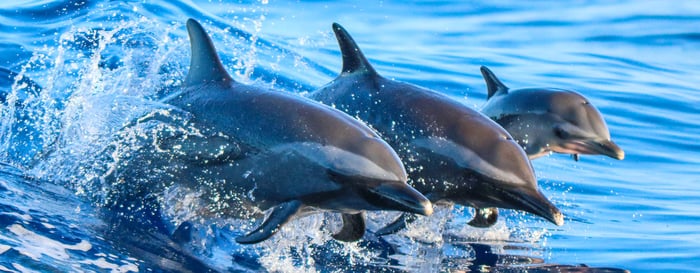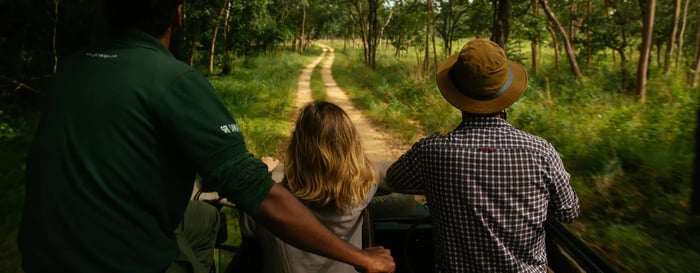My head is thumping. My eyes are stinging. I’m weak with thirst. The dunes behind glow a deep shade of ochre. In front is nothing. Nothing at all. A gravel plain stretches to the horizon and for hundreds of miles beyond. I feel overwhelmed by the scale of the desert and by the hundreds of silent, scorching miles that still lie ahead. I haven’t showered or slept in a bed for weeks.
I’m hungry, thirsty, and weary from hauling heavy, but tightly rationed supplies in a homemade cart. Yet there is nowhere on Earth that I would rather be. This is the Empty Quarter, the world’s largest sand desert, on the Arabian Peninsula. I have waited 15 years to get here.
In England, inspiration and history lurk around every corner, making it a fine place for a young man to be when he first begins to dream of adventure. I was at Oxford University when I first read about explorer and travel writer Wilfred Thesiger. He studied there and daydreamed there, like me. Thesiger became one of my heroes. Inspired by him, I even joined the university boxing club — a foolish and short-lived venture.
After Oxford, Thesiger fought in World War II with the SAS, the British Special Forces whose motto is “Who Dares Wins.” Thesiger hated modernization, automobiles, and easy living.
Following the war, he travelled the world, notably spending years with the Bedu in Arabia and the Marsh Arabs in Iraq, earning the moniker, “Mubarak bin London,” Arabic for “the blessed one from London.”

Major Sir Wilfred Patrick Thesiger, CBE, DSO, FRAS, FRGS — to give his full title — was the stereotypical old-fashioned British explorer: tall, craggy-featured, and equally at ease wearing Arab robes or a sharp London three-piece suit. He was eccentric, hard-as-nails, and lived a life filled with extraordinary adventure.
Thesiger had “the man’s courage to live out the boy’s dream.” His greatest book, Arabian Sands, is considered a classic of British travel writing. It encouraged me to think ambitiously, but simply, about big journeys of my own. His prose is sparse and measured, thoughtful and honest. He was committed to always testing himself. He lived ascetically and strived to match the Bedu’s high standards: The harder the life, Thesiger believed, the finer the person. And ever since I read Arabian Sands I dreamed of one day making a journey in his footsteps, into the Empty Quarter desert.
Thesiger and his Bedu companions made a series of epic journeys into the unexplored interior of the Empty Quarter in the 1940s. My journey was inspired by him, but didn’t pretend to replicate any of his routes. There were pragmatic reasons for this.
It is no longer permitted to wander at will around Saudi Arabia. I had no idea how to drive a camel, and couldn’t afford one anyway. Truth be told, I’m scared of them too. Nor could I roam at will across the desert. Saudi Arabia is off-limits to today’s adventurous tourists, so I would be constrained to the desert in Oman and the United Arab Emirates.
My aim was to string together segments from Thesiger’s different journeys and to become a human camel, hauling a homemade cart with nearly 700 pounds of supplies for 1,000 miles across the Arabian Peninsula from Salalah in southern Oman to the glitzy madness of Dubai in the United Arab Emirates.
I’d need some help with this madcap plan, so I recruited Leon McCarron, a fellow adventurer and admirer of Thesiger, to accompany me. I barely knew Leon, but then it’s not always easy to find volunteers for this kind of expedition. Besides, we would have plenty of time out there in the sands to get to know one another…
Our trip was last-minute and very low-budget. A farmer I knew built a cart to the design Leon and I gave him. We only had time for one day of training. And that day — shivering in the rain on the beach in an out-of-season English seaside town — really did not feel like ideal preparation for what awaited us in the desert.
Out in Salalah, on Oman’s southern coast, we loaded up the cart with nearly 30 gallons of water and a month’s supply of instant noodles, biscuits, and tins of mysterious-looking meat. We began hauling our cart down the road, bursting with heroic excitement. After 15 years of daydreaming, my Thesiger adventure was at last underway.
And then it stopped.

Within moments of setting off, Leon and I discovered that our cart, fully loaded for the first time, did not steer. It was a disaster. We continued stubbornly for a few hours, manhandling the useless contraption down busy, noisy roads, and cursing our own incompetence. The whole journey was collapsing before our eyes. At dusk, without having even made it out of town, we gave up.
So often the highlights of adventures emerge from bad situations and revolve around the people you meet along the way. And so it was here. Over the next three days we met a wonderful cast of people in Salalah’s backstreet workshops. With great skill and imagination, they welded and whacked and bodged a steering system onto our cart. This cast of cheery strangers saved us from our own ineptness and rescued the expedition.
We began once again. To our enormous relief, this time the cart worked properly. It looked ridiculous, but we didn’t care. We hauled it out of town and along busy highways until, after a few days, we turned off the road and into the empty desert.
Oman’s desert is frequently crisscrossed with gravel tracks and the trails of 4WD vehicles that zoom around the desert either for fun or rounding up some of their far-spread camels. So even here we couldn’t entirely leave the world behind. But we got the silence, the stillness and — above all — the heat that Thesiger endured. We lived on a strictly rationed amount of water and the most basic of supplies. We needed to carry food for a month, so we had no fresh food or refrigerated food. Our diet of instant noodles, biscuits, nuts and dates was not particularly inspiring.
The days settled into steady routine. Each morning we woke two hours before dawn, pack quickly, and begin to walk. We were quiet at first, waking gradually as we walked.

I loved the first hours of each day. The air was fresh and Venus was low and bright on the eastern horizon. With sunrise, colour and conversation and laughter came flooding into the world. The colours of this adventure were limited but striking: the bright blue of a permanently cloudless sky, and the simple shades of orange and red desert.
Soon after sunrise the heat built and built until it dominated all of our thoughts. We would walk for an hour, then pause briefly for a sip of water and a bite to eat. Then we would walk again. We repeated this over and over until the midday heat overwhelmed us.
And then we would shelter and swelter in the shade of a small canopy through the worst hours of heat. The tarpaulin we had brought to provide this crucial shade had performed admirably when I tested it in my garden. But the sun in the Empty Quarter desert turned out to be rather fiercer than England’s in October and our tarpaulin was useless.
In the afternoon we would keep walking, until night had fallen and we’d covered the day’s required distance. The repetitive nature of the landscape offered little mental respite or diversion. Dragging the cart was hard work, and the age-old desert hardships that Thesiger encountered resonated as much today as ever:
“The ever-present hunger and thirst, the weariness of long marches: these provided the challenge of Bedu life against which I sought to match myself, and were the basis of the comradeship which united us.” — Wilfred Thesiger.

Difficult though the journey was, I tried always to remind myself that, like Thesiger, “if I were in London I would give anything to be here.” And as we walked and sweated, Leon and I would chat about how different our experience was to Thesiger’s. We had maps. We had strong plastic jerry cans filled with water rather than flimsy, leaking goat skins.
But although much was different, much was similar too: the endless, unchanging gravel plains that shimmered all the way to the horizon and far beyond. The beautiful, sculpted dunes that looked different as the day progressed and the shadows lengthened. Their colours varied from a grey shade of khaki, through orange, to a deep shade of red that glowed with the last of the setting sunshine.
The reward for our hardship was the simplicity of the life we were experiencing. Everything else was left behind. All we needed to do was walk. All we had to worry about was the journey. All we desired was food, water, and sleep. Jokes felt funnier. When we were fortunate enough to hear it, music sounded more powerful, more emotional. Escaping from the madness of modern life to the simplicity of the desert was extremely satisfying.
The landscapes were vast and changed only slowly. There were tall dunes that rose steeply and beautifully from the desert floor. But most of the time our surroundings were absolutely flat and empty. To stand on a gravel plain, spin 360 degrees, and see and hear nothing at all, made us feel very small indeed. Thesiger described this as, “the silence we have driven from our world.”
Much of the time we were on small gravel tracks or proper roads. We passed gas and oil installations and small settlements. The only thing that never changed was the slowness of our pace. I found it frustrating but cathartic to spend a whole day working hard to reach a spot that we had been able to see since we’d set out that morning.

When we stopped at night, an hour or two after sunset, we would simply lay out our sleeping bags. No tents, no preparation, no hassle. We just stripped off sweaty shirts, cooked dinner, and then fell asleep.
This was our favourite time of day, when the ferocity of the heat had passed. We had miles in the bag (we walked a marathon, every day, for those 1,000 miles). We could look forward to camping and resting. There were no showers, no days off. But to remove our harnesses at day’s end and set up camp was reward enough. I loved lying back on the still-warm sand and listening to the soft roar of our camping stove.
This weariness, sense of achievement and towering air of remoteness is the one thing that we did share with Thesiger, and my favourite part of the journey. This repetitive, simple life continued day after day, week after week. The ascetic, almost monastic routine of a desert adventure is one of its toughest but most rewarding aspects.
And so the miles and hours and days and weeks passed. Leon and I had time a-plenty to get to know one another. In amongst the usual expedition conversations (food, women, more food), we continued to discuss Thesiger’s journeys and wondered what he would make of our amateur efforts.
The local people who Thesiger held in such high regard no longer live such a harsh existence. On our journey they wound down the windows of their air-conditioned 4WDs to take photos of the crazy Brits on their camera phones. We caused hilarity wherever we went.
The laughter was good-natured and the people were extraordinarily generous, showering us with gifts that ranged from the sensible (bottles of water) to the luxurious (an entire watermelon, ice creams — yes, ice creams in a desert) to the bizarre (a bottle of aftershave).
One afternoon a huge red truck juddered to a halt in front of us. The driver, Ali, leaped from his cab to shake our hands. We sat together in the shade of his truck as he lit a fire and prepared coffee for us.
I enjoyed this demonstration of timeless Bedu tradition and hospitality blended with the modern reality of a very different land to the idyllic one that Thesiger explored. To his dismay, a westernized fate for the Middle East seemed inescapable. In the foreword to Arabian Sands, Thesiger warns that in the years since his journeys there, the region had begun to show signs of the modernization he so abhorred.
“If anyone goes there now looking for the life I led they will not find it… Today the desert is scarred with the tracks of lorries and littered with discarded junk imported from Europe and America.” — Wilfred Thesiger

At first it had saddened me that there were vehicles and oil platforms in the desert, that truck-stop cafes were selling hot curry and cold Pepsi. But there is no point yearning for the past. Thesiger would have been astonished to see how much the region had changed in just a few generations.
We left the desert behind as we crossed the border into the United Arab Emirates. Flashy cars raced past, their once-nomadic inhabitants now cocooned in air-conditioned comfort. We trudged weary down the busy motorway to Dubai, pushing through the final 200 miles with dreams of ice creams and cold showers.
Thesiger would have thought us soft. He would have been amazed by Dubai as well. In his day it was a small fishing town. And nothing could have astonished him more than the place we had chosen for the finale of our expedition — the top of the tallest building on Earth, the Burj Khalifa, in Dubai — spearing into the sky high above all of the other extraordinary skyscrapers.
Dubai is a surreal place however you experience it. But to arrive on foot, after walking for 1,000 miles, was one of the weirdest and most memorable ends to an adventure I have ever known. It seemed like a perfectly ludicrous summary of how this part of the world has changed since Thesiger’s time. We felt so out-of-place in the shiny shopping malls of Dubai. We hadn’t washed in weeks. The modern city was an amusing place to finish our journey. I cannot imagine that many of my future expeditions will come to an end outside a Dolce&Gabbana store.
Leon and I are very different than Thesiger. He would doubtless have frowned at our journey, which was amateur, decadent, and wimpish by comparison. Thesiger and his companions frequently went for long periods with little food or water.
They regularly exchanged rifle shots with bandits. Leon and I had over a gallon of water each day and the only shooting of locals was with our cameras. But enduring less extreme hardships didn’t damper my experience. As Thesiger wrote in Arabian Sands:
“No man can live this life and emerge unchanged. He will carry, however faint, the imprint of the desert, the brand which marks the nomad; and he will have within him the yearning to return, weak or insistent according to his nature. For this cruel land can cast a spell which no temperate clime can match.” — Wilfred Thesiger, 1959
To watch the award-winning film of this adventure click here.
Photos courtesy of Alastair Humphreys.
Speak to a Lightfoot Travel expert today to orangise a bespoke trip to the Arabian Peninsula, combining desert adventures and dazzling cities.
Family Adventure in California
California United States of America North America
- Visit the home of the stars
- Drive along the winding Californian coast
- Explore Yosemite Valley and Lake Tahoe
- Go white water rafting on the American River
- Discovering San Francisco’s laid-back atmosphere
Mongolia for Families
Ulaanbaatar & Central Heartland
- The kids will love the experience of sleeping in traditional Mongolian felt tents, or ‘gers’
- Whether it’s horse ack riding or walking, get the kids out in nature and be active all throughout this vacation
- Learn about Mongolian culture first-hand by staying alongside a nomadic host family, helping them with their daily chores and letting the kids play and interact with the host children
Sri Lanka with Kids
Colombo Galle Fort Sri Lankan Safaris Sri Lanka's Cultural Triangle Sri Lanka
- Explore the city of Anuradhapura, one of the most important sites in medieval Asia
- Visit the rock fortress of Sigiriya and the Dambulla Cave Temple
- Wind through the Central Highlands by rail and visit a tea plantation
- See Sri Lanka’s wildlife on game drives in the Yala National Park
- Relax on pristine beaches, and enjoy watersports and whale watching










